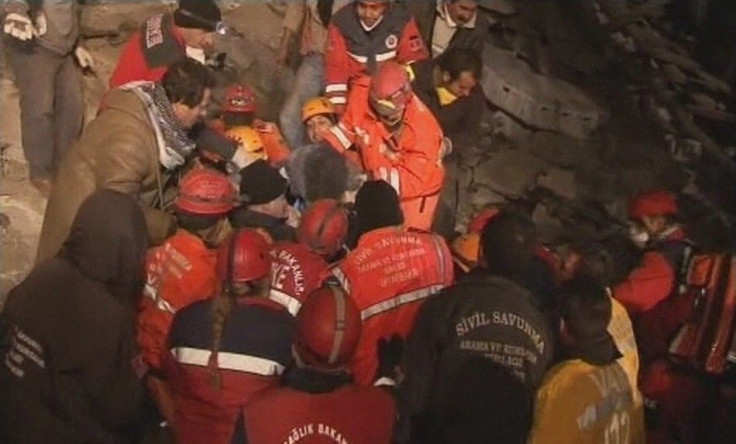Rescuers Dig for Survivors Following Latest Turkey Earthquake

In Van, Turkey, rescue workers have pulled 23 people out from under collapsed buildings following a 5.7 magnitude earthquake on Wednesday night. But, the search for more survivors continues, and dozens of people could still be buried.
Twenty-five buildings collapsed during the earthquake, including two hotels where a number of journalists and rescue workers were staying. So far, eight people have been confirmed dead, including a Japanese doctor named Atsushi Miyazaki, who was found alive but later died in a hospital.
“We’re hoping the loss of life won’t be too much, but we’re taking all the action we can, as fast as we can,” Deputy Prime Minister Besir Atalay said on Turkish television.
Around 800 rescuers worked through the night, using high-powered lights to illuminate digging sites. Sadly, they have had a lot of practice searching for bodies recently.
Van in Turkey's heavily Kurdish southeast was the site of a large earthquake less than three weeks prior. On Oct. 23, a 7.2 magnitude quake hit the city, killing more than 600 people, most of them dying beneath the rubble of destroyed buildings and homes.
Many of the houses that collapsed on Wednesday were uninhabited, having been deemed unsafe after the October quake. Scores of people are still living outdoors and in tents as a result of the earthquake three weeks ago. Some are too afraid to return home. Other have no home to which to return.
Earthquakes in Turkey are not uncommon, but the quake in October was the worst since the 1999 ?zmit earthquake that killed more than 17,000 people and left 60,000 more homeless. Many of the people who died then were crushed when poorly built houses collapsed during the 7.6 magnitude tremor.
The country gets hit by earthquakes of magnitude 6.0 or greater every couple of years, especially in the eastern region where the quake hit Wednesday.
There are three major fault lines running through Turkey: the North Anatolian Fault, the East Anatolian Fault and the Bitlis-Zagros Fold and Thrust Fault, all of which converge about 120 miles northwest of Van. Additionally, three tectonic plates meet in Turkey -- the Anatolian Plate, the Eurasian Plate and the Arabian Plate -- making it particularly susceptible to earthquakes.
A report on the Oct. 23 quake from the Southern California Earthquake Center notes that Turkey is a tectonically active country that experiences frequent destructive earthquakes.
© Copyright IBTimes 2024. All rights reserved.











